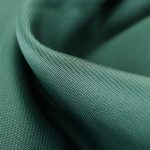If you’re exploring Banarasi Katan silk fabric, you’ll find it’s a rich blend of heritage and craftsmanship from Varanasi, known for its smooth texture and intricate floral and paisley patterns. Its pure silk threads create durable, luxurious textiles favored for special occasions like weddings. You’ll appreciate the traditional weaving techniques and the care needed to keep its vibrant colors and delicate fibers lasting longer. Keep going to uncover styling tips and authentic identification methods.
Table of Contents
Key Takeaways
- Banarasi Katan silk originates from Varanasi, India, reflecting rich cultural heritage and centuries-old royal artistry.
- It features intricate floral, paisley, and geometric patterns woven using traditional handloom techniques like Jacquard and extra weft.
- The fabric is made from pure silk threads, offering a smooth, dense weave with a luxurious finish and durable texture.
- Commonly used for sarees, lehengas, and accessories, Banarasi Katan silk suits weddings and festive occasions with elegant style.
- Proper care involves protecting from sunlight, storing in cool dry places, gentle cleaning, and avoiding moisture to preserve fabric quality.
Origin and Historical Significance of Banarasi Katan Silk
Although Banarasi Katan silk has ancient roots, it continues to captivate you with its rich history and exquisite craftsmanship.
Originating from Varanasi, India, this fabric reflects centuries of cultural heritage. You’ll find its legacy intertwined with royal patronage, as Mughal emperors favored Banarasi silks for their opulence and durability.
When you wear Banarasi Katan silk, you connect with artisans who’ve passed down weaving traditions for generations. This fabric isn’t just a textile; it’s a symbol of artistry and status, often used in special ceremonies and weddings.
Its historical significance lies in how it embodies the fusion of art, culture, and tradition, making every piece you own a living artifact of India’s vibrant past.
Unique Weaving Techniques and Patterns
You’ll notice Banarasi Katan silk stands out because of its traditional weaving methods that have been passed down for generations.
The signature motifs and intricate threadwork create patterns that are both rich and elegant.
As you explore, pay attention to the fine embellishments that add a unique charm to each piece.
Traditional Weaving Methods
When you explore Banarasi Katan silk fabric, the traditional weaving methods stand out for their intricate designs and meticulous craftsmanship. You’ll notice that artisans use handlooms, blending silk and zari threads with precision. This age-old technique demands patience and skill, ensuring each piece is unique.
Here’s a quick look at key weaving methods:
| Method | Description |
|---|---|
| Jacquard Loom | Automates pattern weaving |
| Handloom Weaving | Manual process, highly detailed |
| Extra Weft | Adds supplementary threads for texture |
| Dobby Weaving | Creates geometric patterns |
Signature Motifs and Designs
Banarasi Katan silk fabric captivates with its signature motifs and designs, crafted through unique weaving techniques that bring each pattern to life.
When you explore these fabrics, you’ll notice how traditional artistry and precision combine to create timeless elegance. The motifs often draw inspiration from nature, architecture, and cultural symbols, each telling a story woven in silk.
You’ll find patterns like:
- Floral Vines: Delicate and flowing, these represent growth and beauty.
- Paisley Shapes: Classic and intricate, symbolizing fertility and life.
- Geometric Borders: Sharp and symmetrical, adding structure and balance.
Threadwork and Embellishments
Intricate threadwork and exquisite embellishments bring Banarasi Katan silk to life, showcasing the weaver’s skill and creativity.
When you look closely, you’ll notice the fine zari threads—often gold or silver—that form delicate patterns on the fabric. These threads intertwine with the silk to create shimmering motifs, enhancing the fabric’s richness.
You’ll find unique weaving techniques like “kadhua” and “butidar,” where tiny, repetitive patterns add texture and depth. Additionally, the embellishments may include subtle floral or geometric designs, achieved through handloom weaving.
This meticulous craftsmanship guarantees every piece of Banarasi Katan silk stands out with its elegance and detail. When you wear it, you carry centuries of heritage woven into every thread.
Characteristics That Define Banarasi Katan Fabric
You’ll notice Banarasi Katan fabric stands out because of its smooth texture and intricate weave.
The designs are detailed, often featuring traditional patterns that tell a story.
Understanding these characteristics helps you appreciate the fabric’s true beauty.
Texture and Weave
The rich interplay of texture and weave gives Katan silk its unmistakable charm and durability. When you touch Banarasi Katan, you feel a smooth yet sturdy fabric woven from pure silk threads.
Its weave is tight, creating a fine, dense surface that holds intricate patterns without losing strength. This texture guarantees longevity and a luxurious feel.
Here’s what you should know about its texture and weave:
- Pure silk threads: Katan uses double-twisted silk, enhancing strength and smoothness.
- Tight weave: The close interlacing of threads results in a firm, durable fabric.
- Luxurious finish: The fabric’s surface gleams subtly, reflecting light beautifully without harsh sheen.
This balance of texture and weave makes Katan silk distinct and perfect for special occasions.
Design and Patterns
Along with its smooth texture and tight weave, Banarasi Katan silk stands out because of its distinctive designs and patterns.
When you look closely, you’ll notice intricate floral motifs, paisleys, and geometric shapes that are traditionally handwoven using gold and silver zari threads.
These patterns aren’t just decorative—they reflect centuries of craftsmanship and cultural symbolism unique to Varanasi.
You’ll find that the motifs often cover the entire fabric or form elegant borders and pallu designs.
The precision of these patterns comes from skilled artisans who meticulously plan each thread’s placement, ensuring symmetry and richness.
When you wear Banarasi Katan silk, you’re embracing both artistic heritage and luxurious detail that few other fabrics can match.
Popular Uses and Styling Ideas
When you choose Banarasi Katan silk fabric, you tap into a domain of elegance that suits both traditional ceremonies and contemporary fashion.
This luxurious fabric lends itself beautifully to various uses, making your wardrobe versatile and timeless. You can easily elevate your style with its rich texture and intricate patterns.
Consider these popular uses and styling ideas:
- Sarees and Lehengas: Perfect for weddings and festive occasions, offering a regal look.
- Blouses and Kurtis: Pair with simpler bottoms for a chic, balanced outfit.
- Accessories: Use scraps to craft elegant clutches, stoles, or ties that add a touch of sophistication.
How to Identify Authentic Banarasi Katan Silk
How can you tell if Banarasi Katan silk is truly authentic? First, examine the fabric’s texture—it should feel smooth yet firm, with a subtle sheen that reflects light evenly.
Authentic Katan silk is woven from pure silk threads, so it won’t feel coarse or overly shiny like synthetic blends. Look closely at the zari work; genuine Banarasi silk features intricate, handwoven gold or silver threads that are tightly integrated without loose ends.
Pure silk threads and tightly woven, intricate zari distinguish authentic Banarasi Katan silk from synthetics.
You can also check the weight—it’s lighter than heavy brocades but still substantial.
Finally, test its burn quality carefully: real silk burns slowly, smells like burnt hair, and leaves a soft ash, unlike synthetic fibers. Trust your senses and always buy from reputable sources to guarantee authenticity.
Tips for Caring and Maintaining the Fabric
Knowing how to spot authentic Banarasi Katan silk guarantees you’re working with a delicate, valuable fabric that deserves careful handling.
To keep your silk vibrant and intact, you need to treat it gently and store it properly. Always avoid harsh chemicals and excessive friction, as these can damage the fine threads and intricate patterns.
Here are some essential tips for caring for your Banarasi Katan silk:
- Store it in a cool, dry place, preferably wrapped in muslin or cotton cloth to allow the fabric to breathe.
- Dry clean only; avoid washing at home to maintain the fabric’s sheen and texture.
- Keep it away from direct sunlight to prevent color fading and weakening of fibers.
Following these guidelines will guarantee your Banarasi Katan silk stays beautiful for years.
Frequently Asked Questions
What Is the Price Range of Banarasi Katan Silk Fabric?
You’ll find Banarasi Katan silk fabric prices vary widely, typically ranging from $50 to $500 per yard. The cost depends on design intricacy, silk quality, and craftsmanship, so expect higher prices for premium pieces.
Are There Synthetic Alternatives to Banarasi Katan Silk?
Yes, you’ll find synthetic alternatives like polyester or nylon blends mimicking Banarasi Katan silk’s look. They’re more affordable and easier to maintain, but they won’t quite match the original’s luxurious feel and breathability.
How Long Does It Take to Weave a Banarasi Katan Saree?
As you watch the shuttle glide and threads intertwine, you’ll realize weaving a Banarasi Katan saree takes anywhere from 15 days to several months, depending on the intricacy of its stunning, detailed patterns.
Can Banarasi Katan Silk Be Used for Home Décor?
You can definitely use Banarasi Katan silk for home décor. Its rich texture and intricate patterns add elegance to cushions, curtains, or wall hangings, but be mindful of its delicate nature and avoid heavy wear or sun exposure.
Where Can I Buy Certified Authentic Banarasi Katan Silk Online?
Finding certified authentic Banarasi Katan silk online is like discovering a hidden treasure. You’ll want to check trusted sites like Craftsvilla, Fabindia, or directly from Banarasi weavers’ official stores to guarantee genuine quality and certification.
- Technical Deep Dive: A Two-Step Reactive Extrusion for Polyamides - June 30, 2025
- Designing a Polyamide Flat-Belt Drive System: Key Considerations - June 30, 2025
- Applications of a 6-Inch Wide Polyamide A-3 Belt - June 30, 2025







